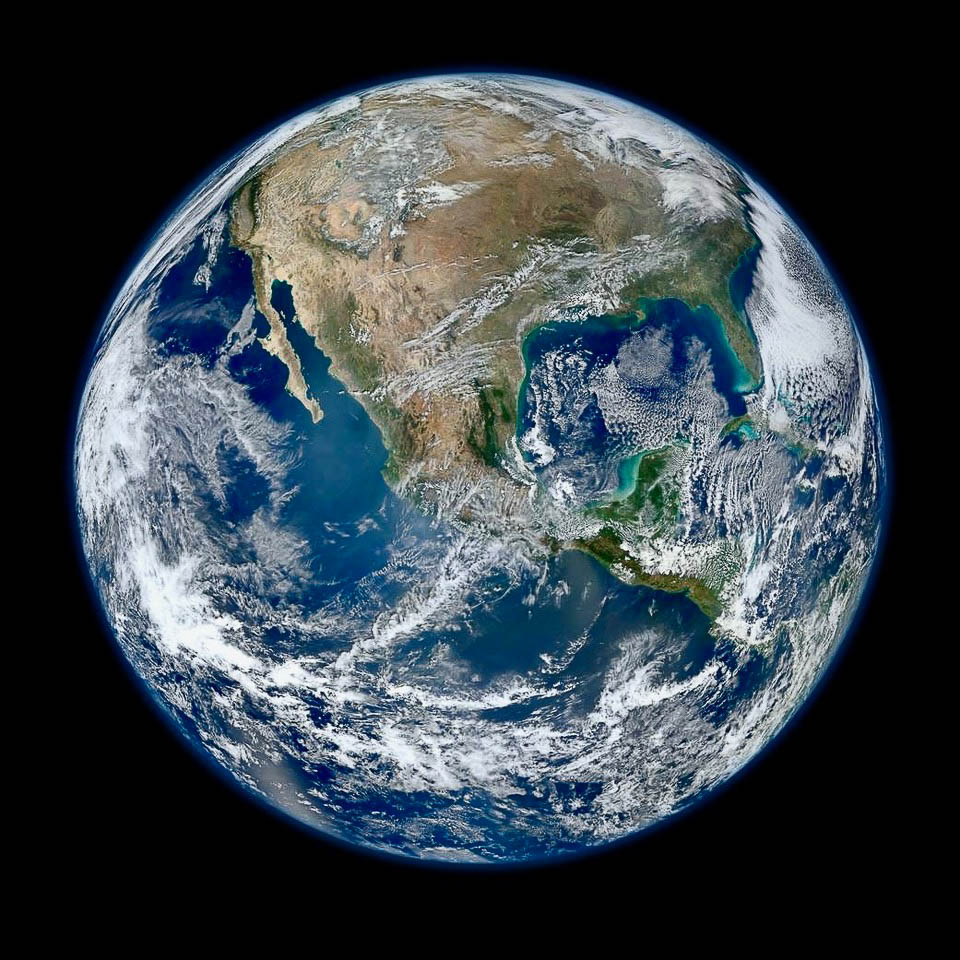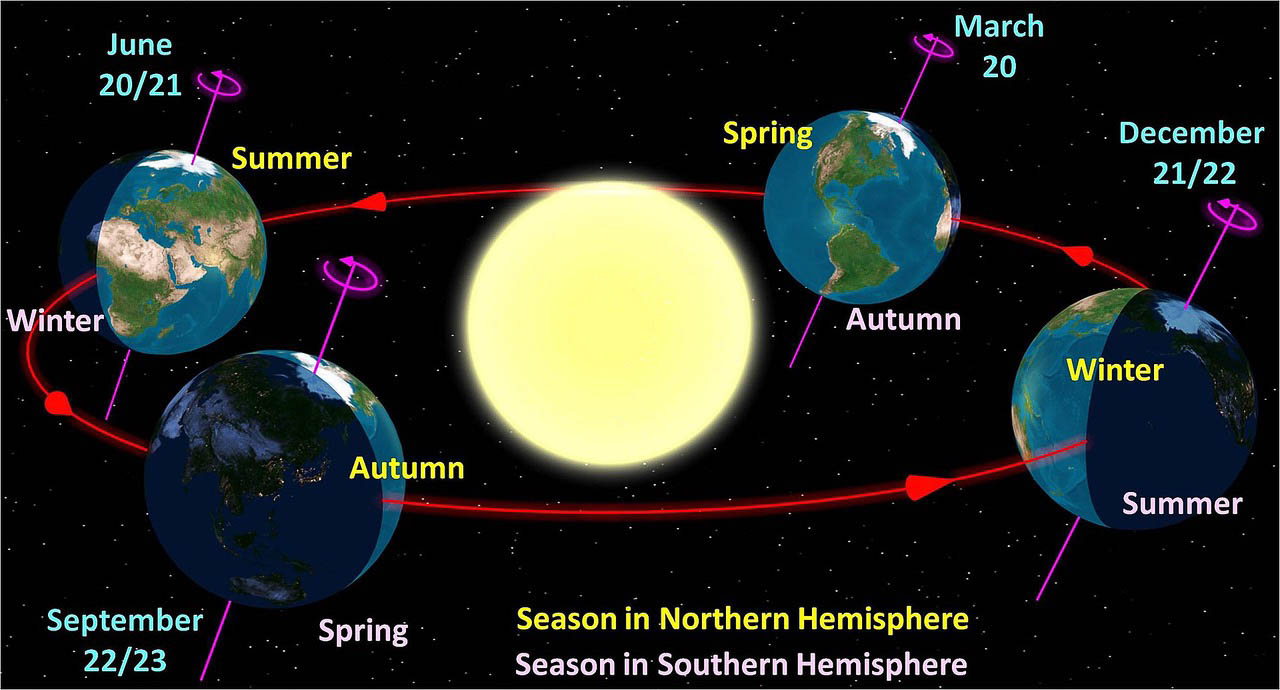ePostcard #160: Earth’s Journey Around the Sun
Photo Illustration Credit: Courtesy of NASA/NOAA/GSFC/Suomi NPP/VIIRS/Norman Kuring. This extraordinary image of the Earth—the ‘Blue Marble’ that is our home planet—was captured in 2012. Scanning down the left side of the photo you see the west coast of the United States, the Sierra Nevada, Mexico’s Baja Peninsula, the Gulf of California (also known as the Sea of Cortés) and the Mexican mainland, Central America, and the northwestern portion of South America. As you scan to the east you can pick out the Gulf of Mexico, the southeastern U.S. (the long peninsula is Florida) and a bit of the eastern seaboard.
THE POWER OF THE SUN
Nothing is more important to life on Earth than the Sun. When I think about the annual Earth-Sun orbit that launches the beginning of each new year, I’m fascinated by all the ways in which Earth’s epic voyage around the Sun shapes our lives as well as the biodiverse multitude of life forms and ecosystems that make up the world around us. Without the Sun’s heat and light—solar energy—Earth’s amazing ‘Blue Marble’ would not exist. Solar energy has existed as long as the Sun—about 5 billion years. Without heat from the sun, Earth would freeze. Solar energy warms our seas, powers the ocean currents that circle the globe, stirs our atmosphere, generates the climate and weather patterns we experience on Earth, and the clouds that transport water in all its myriad forms across the globe.
Despite all of the imaginary borders we set up to define ourselves—our homes, neighborhoods, cities, and countries—we’re all spinning through space on the same blue sphere. What happens on Earth matters to all of us in more ways than many of us can imagine.
Photo Illustration Credit: NASA/Terry Virts. Like all the planets in our Solar System, Earth orbits around the Sun. A year is measured by how long it takes a planet to orbit around its star. The Earth-Sun orbit takes about 365 days and 6 hours. Planets that orbit closer to the Sun than Earth have shorter years than Earth. Planets that orbit farther from the Sun than Earth have longer years than Earth.
A YEAR IN THE MAKING: THE EARTH-SUN ORBIT
The Sun is the star at the center of the Solar System. As you look at the night sky from a spot where light pollution is minimal, it may surprise you that the Sun is the closest star to Earth. It is a nearly perfect ball of hot plasma, heated to incandescence by nuclear fusion reactions in its core. The Sun radiates this energy mainly as light, ultraviolet, and infrared radiation, and is the most important energy source for life on Earth.
The Sun’s radius is about 432,000 miles (695,000 kilometers), or 109 times that of Earth. Its mass is about 330,000 times that of Earth, comprising about 99.86% of the total mass of the Solar System. Every second, the Sun’s core fuses about 600 million tons of hydrogen into helium, and in the process converts 4 million tons of matter into energy. This energy, which can take between 10,000 and 170,000 years to escape the core, is the source of the Sun’s light and heat.
Scientists refer to Earth’s two-dimensional orbital plane around the Sun as ecliptic. Most of the planets of our Solar System, such as Mercury, Venus and Mars, orbit the Sun in nearly the same ecliptic plane as Earth. From the perspective of an observer on Earth, the Sun’s movement around the celestial sphere over the course of an orbit year traces out a path along the ecliptic against a background of stars. The Earth-Sun orbit takes a little more than 365 days to complete, with Earth maintaining an orbit distance from the Sun of about 93 million miles (150 million kilometers) To complete this epic 584 million mile (940 million km) journey, our beloved planet hurtles through space at an average speed of about 67,000 miles per hour (108,000km/h).
HOW WE ARE STUDYING THE SUN
Solar Orbiter, a spacecraft of the European Space Agency, launched in February of 2020 and has been looping around our star ever since its inaugural. “Solar Orbiter’s mission is to explore the Sun and the surrounding heliosphere – the big plasma bubble that the solar wind blows into the interstellar medium,” says Daniel Müller, project scientist for Solar Orbiter at the ESA. “The driving rationale for Solar Orbiter is to establish the connections between what our home star does in terms of activity and how that manifests itself in the surrounding heliosphere, including the near-Earth environment. “We combine measurements of the plasma at the location of the spacecraft with images of the Sun.”
Illustration Photo Credit: NASA, Johns Hopkins APL, Steve Gribben. NASA’s Parker Solar Probe, shown above, is one of many spacecraft studying the Sun.
NASA’s Parker Solar Probe is also traveling around the Sun. Just a month before Solar Orbiter’s closest approach, Parker made its 11th perihelion journey, coming just 5.3 million km from the Sun’s photosphere – the Sun’s ‘surface’ layer, which emits the light we can see from Earth. To put this in perspective, if Solar Orbiter gets close to the Sun, then the Parker Solar Probe brushes right past it. This is so close that it actually passes through the outer layer of the Sun’s atmosphere, the corona. “Parker essentially takes a deep breath and flies into the Sun, hopefully coming out in one piece to downlink the data,” says Müller.
The solar probes will continue their science phases as they spiral closer towards the Sun, and their contributions to science will be magnified by their collaborative effort. While Parker takes a direct look at what is happening close to its surface, sniffing the solar wind and plasma, Solar Orbiter can take a wider look at what is going on. At the same time, the existing solar observatories based on the ground and closer to Earth orbit will be able to look at the whole Sun, giving a global view.
SEASONS OF LIFE
As well as orbiting the Sun, the Earth is also spinning on an axis running through the North and South Poles – this is what gives us day and night. Earth rotates at 1,030 mph (1,670km/h) around the polar axis, but it doesn’t do this at right angles to its orbital path. The axis is tilted over by 23.5°. Do you remember the tilting Earth globes you saw in elementary school libraries? They represent our planet as it sits in space going around the Sun – something that’s technically known as Earth’s ‘obliquity of the ecliptic’. With the tilted Earth going around the Sun, over the course of a year we can start to make sense of the astronomical points that mark the start of the seasons.
It is the Earth’s relationship to the Sun, and the amount of light it receives, that is responsible for the seasons we experience and biodiversity as we know it. Throughout the year, different parts of Earth receive the Sun’s most direct rays. So, when the North Pole tilts toward the Sun, it’s summer in the Northern Hemisphere. And when the South Pole tilts toward the Sun, it’s winter in the Northern Hemisphere. The Earth also rotates on its axis during this journey, which is tilted at 23 degrees and 27 minutes relative to its orbital plane about the Sun, completing one revolution every 24 hours with respect to the Sun (23 hrs 56 min with respect to the stars). This produces the seasons we experience on the surface of the Earth.
In our next ePostcard, we will learn about the circadian rhythms and how how all life responds to these dynamic life forces. Stay tuned!
To help build global awareness, we would appreciate it if you would share this post with your friends and colleagues. Please choose one of the options below which includes email and print! Thank you.






Illuminating!
…and Stellar!
Once more, the enchantment of the universe!
Once more, the appreciation of it!
One can hope human will learn to take better care if it.
Thank you, Audrey for a such great article. The photos are stunning!
The opeing image is absolutely stunning. Thank you for another detailed,”illuminating” and “stellar” epizode. Looking forward to the next one.
I love how you explain things that those of us who never went far in science in school can understand. Somehow you manage to make it not only easy to understand, but you inspire awe at the science – how the seasons work, the tilt of the axis of earth. Most of all, it reminds us not to take this planet for granted and how unique and special it is that Earth supports the life and diversity it does. Makes me want with all my heart to love and protect it from the macro to the microcosm with all I’ve got. For the love and wonder of what we’ve been given here.
Very inspiring to be aware that we are sailing through the solar system aboard this wonderful planet called Earth! And thank you very much for your clear explanations that finally made me understand the origin of the seasons.